2003 PONTIAC GRAND PRIX instrument panel
[x] Cancel search: instrument panelPage 230 of 378

Gasoline Specifications
The 8th digit of your vehicle identification number (VIN)
shows the code letter or number that identifies your
engine. You will find the ViN at the top left of the
instrument panel. See Vehicle Identification
Number (VIN) on page
5-96.
Gasoline Octane
If your vehicle has the 31 00 V6 engine (VIN Code J) or
3800 V6 engine (VIN Code
K), use regular unleaded
gasoline with a posted octane of 87 or higher.
If the
octane is less than 87, you may get a heavy knocking
noise when you drive. If
it is bad enough, it can damage
your engine. A little pinging noise when you accelerate or
drive uphill is considered normal. This does not indicate
a
problem exists or that a higher-octane fuel is necessary.
If your vehicle has the 3800 Supercharged V6 engine
(VIN Code I), use only premium unleaded gasoline with
a
posted octane of 91 or higher. In an emergency, you may
be able
to use a lower octane - as low a 87 - if heavy
knocking does not occur. Refill your tank with premium
fuel
as soon as possible. If you are using 91 octane or
higher-octane fuel and you hear knocking, your engine
needs service. It
is recommended that gasoline meet specifications
which were developed by the American Automobile
Manufacturers Association and endorsed by the
Canadian Vehicle Manufacturers Association for better
vehicle performance and engine protection. Gasoline
meeting these specifications could provide improved
driveability and emission control system performance
compared
to other gasoline.
Canada Only
In Canada, look for the
“Auto Makers’ Choice”
label on the pump.
5-5
Page 258 of 378
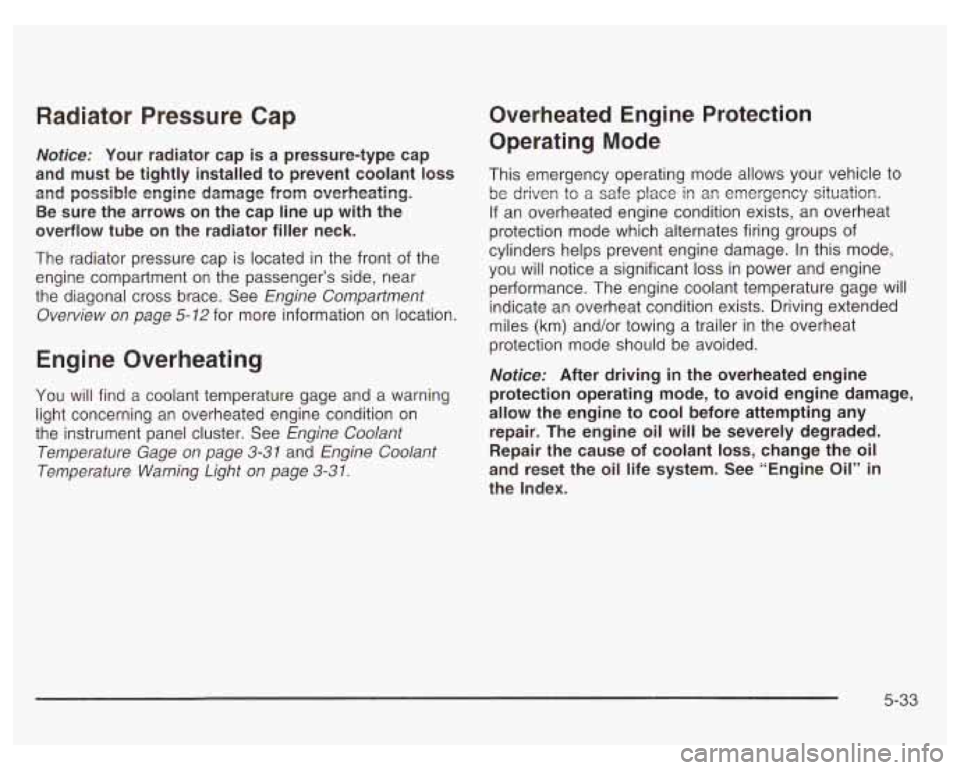
Radiator Pressure Cap
Notice: Your radiator cap is a pressure-type cap
and must be tightly installed to prevent coolant
loss
and possible engine damage from overheating.
Be sure the arrows on the cap line up with the
overflow tube
on the radiator filler neck.
The radiator pressure cap is located in the front of the
engine compartment on the passenger’s side, near
the diagonal cross brace. See Engine Compartment
Overview on page
5-12 for more information on location.
Engine Overheating
You will find a coolant temperature gage and a warning
light concerning an overheated engine condition on
the instrument panel cluster. See Engine Coolant
Temperature Gage
on page 3-31 and Engine Coolant
Temperature Warning Light
on page 3-31.
Overheated Engine Protection
Operating Mode
This emergency operating mode allows your vehicle to
be driven tu
a safe place in an emergency situation.
If an overheated engine condition exists, an overheat
protection mode which alternates firing groups of
cylinders helps prevent engine damage. In this mode,
you will notice a significant
loss in power and engine
performance. The engine coolant temperature gage will
indicate an overheat condition exists. Driving extended
miles (km) and/or towing a trailer in the overheat
protection mode should be avoided.
Nofice: After driving in the overheated engine
protection operating mode, to avoid engine damage,
allow the engine to cool before attempting any
repair. The engine oil will be severely degraded.
Repair the cause of coolant
loss, change the oil
and reset the oil life system. See “Engine Oil”
ir
the Index.
5-33
Page 315 of 378
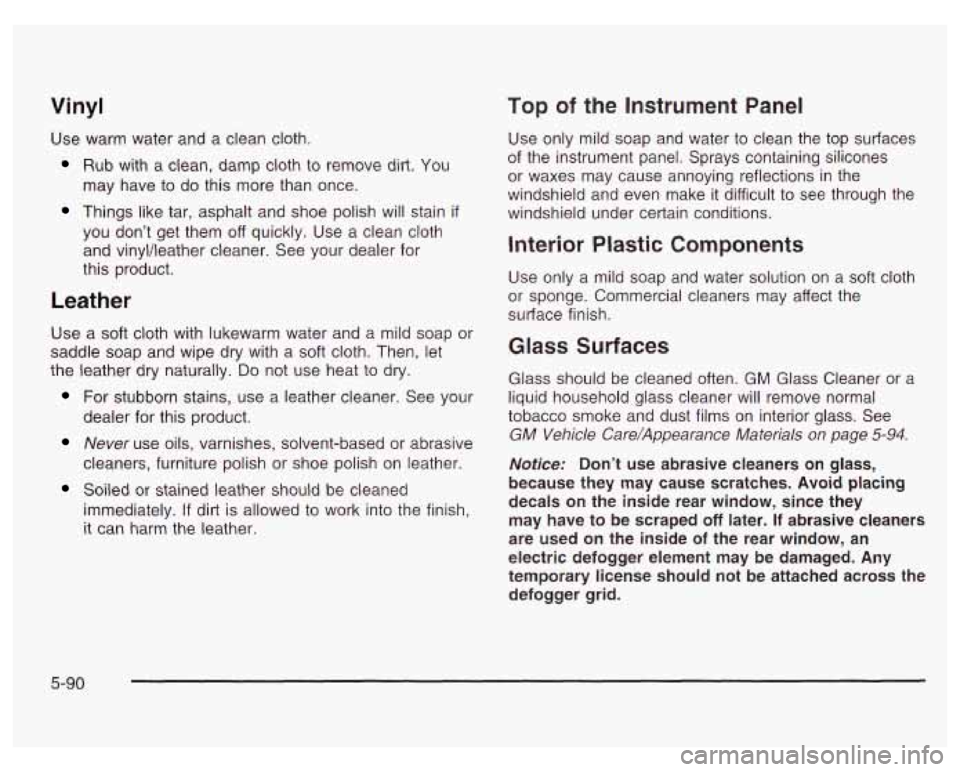
Vinyl
Use warm water and a clean cloth.
Rub with a clean, damp cloth to remove dirt. You
may have to do this more than once.
Things like tar, asphalt and shoe polish will stain if
you don’t get them off quickly. Use a clean cloth
and vinyVleather cleaner. See your dealer for
this product.
Leather
Use a soft cloth with lukewarm water and a mild soap or
saddle soap and wipe dry with a soft cloth. Then, let
the leather
dry naturally. Do not use heat to dry.
For stubborn stains, use a leather cleaner. See your
dealer for this product.
Never use oils, varnishes, solvent-based or abrasive
cleaners, furniture polish or shoe polish on leather.
Soiled or stained leather should be cleaned
immediately.
If dirt is allowed to work into the finish,
it can harm the leather.
Top of the Instrument Panel
Use only mild soap and water to clean the top surfaces
of the instrument panel. Sprays containing silicones
or waxes may cause annoying reflections in the
windshield and even make it difficult to see through the
windshield under certain conditions.
Interior Plastic Components
Use only a mild soap and water solution on a soft cloth
or sponge. Commercial cleaners may affect the
surface finish.
Glass Surfaces
Glass should be cleaned often. GM Glass Cleaner or a
liquid household glass cleaner will remove normal
tobacco smoke and dust films on interior glass. See
GM Vehicle Care/Appearance Materials on page
5-94.
Notice: Don’t use abrasive cleaners on glass,
because they may cause scratches. Avoid placing
decals on the inside rear window, since they
may have to be scraped
off later. If abrasive cleaners
are used on the inside
of the rear window, an
electric defogger element may be damaged. Any
temporary license should not be attached across the
defogger grid.
5-90
Page 321 of 378
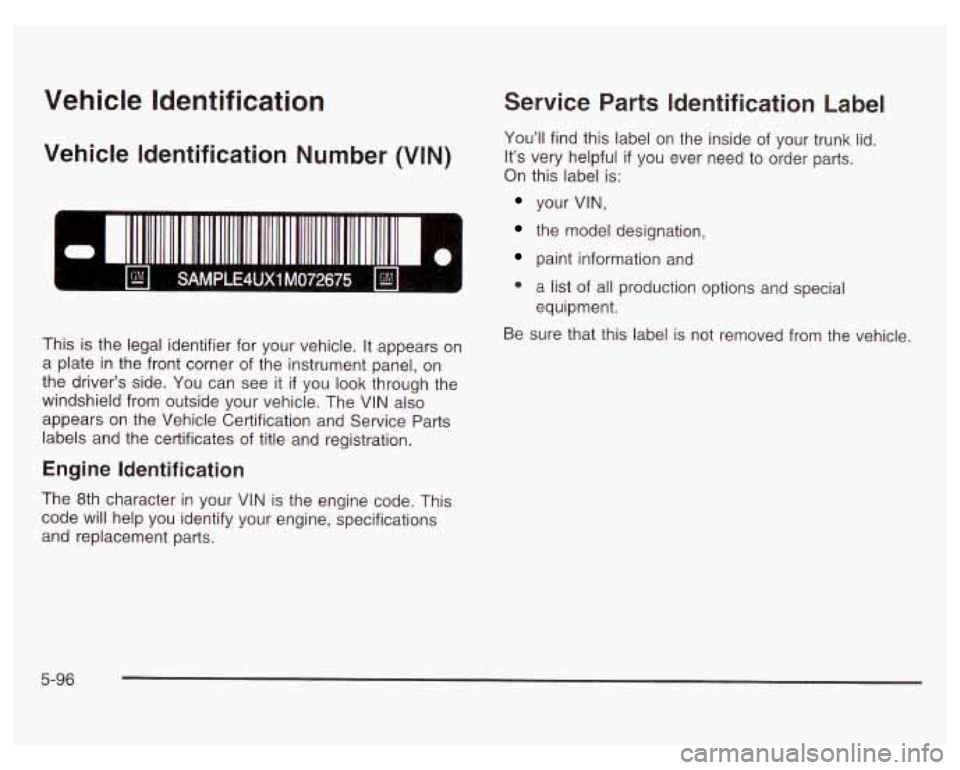
Vehicle Identification
Vehicle Identification Number (VIN)
This is the legal identifier for your vehicle. It appears on
a plate
in the front corner of the instrument panel, on
the driver’s side. You can see it
if you look through the
windshield from outside your vehicle. The
VIN also
appears on the Vehicle Certification and Service Parts
labels and the certificates of title and registration.
Engine Identification
Service Parts Identification Label
You’ll find this label on the inside of your trunk lid.
It’s very helpful
if you ever need to order parts.
On this label is:
your VIN,
the model designation,
paint information and
a list of all production options and special
equipment.
Be sure that this label is not removed from the vehicle.
The 8th character in your
VIN is the engine code. This
code will help you identify your engine, specifications
and replacement parts.
5-96
Page 323 of 378

Instrument Panel Fuse Block
Some fuses are in a fuse block located inside of the
glove box behind a small bin on the right side.
To open,
pull the cover out. The fuse block is inside. On the
back edge of this cover is a fuse usage chart.
To reinstall the bin, position the lower end and turn the
top into position. Press on the sides until it snaps
into place.
CIRCUIT
BREAKERS
(HEADLAMPI
I
I I MALLPGM I MALL I WIPER I I STR WHL
ILLUM I 'TT:rL SUNROOF RADIO
PASSKEY
111
CRUISE
I PWR LOCK
HAZARD
r
FUSE USAGE CHARTI I
STOP LAMP
I/P-IGN HSEATILUM
PWR MIR
ONSTAR
SIR
HVAC
CTRL
R DEFOG
HVAC
HI
TURN
BTSl
DICIHVAC
For More Information. See Owner's Manual
Circuit
Usage
Breakers
HEADLAMP Headlamps
SEAT Power Seat, Power Lumbar
BLANK Blank
PWR WDO Power Windows
I BLANK Bian k
BLANK Blank
BLANK Blank
5-98
Page 349 of 378
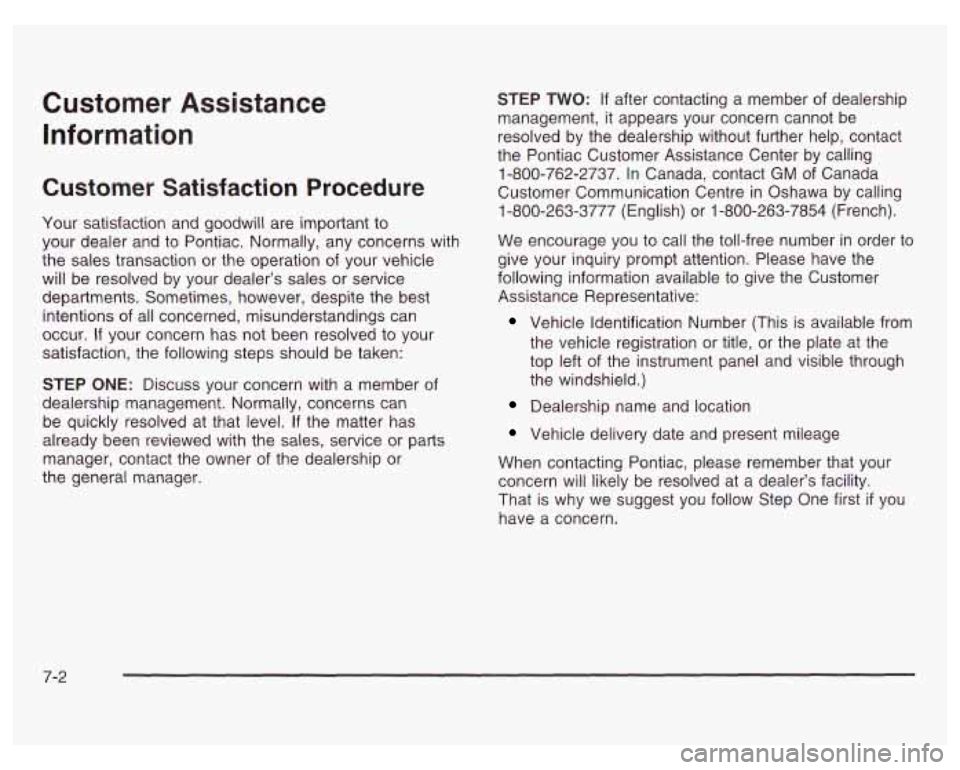
Customer Assistance Information
Customer Satisfaction Procedure
Your satisfaction and goodwill are important to
your dealer and to Pontiac. Normally, any concerns with
the sales transaction or the operation of your vehicle
will be resolved by your dealer’s sales or service
departments. Sometimes, however, despite the best
intentions of all concerned, misunderstandings can
occur.
If your concern has not been resolved to your
satisfaction, the following steps should be taken:
STEP ONE: Discuss your concern with a member of
dealership management. Normally, concerns can
be quickly resolved at that level.
If the matter has
already been reviewed with the sales, service or parts
manager, contact the owner of the dealership or
the general manager.
STEP TWO: If after contacting a member of dealership
management, it appears your concern cannot be
resolved by the dealership without further help, contact
the Pontiac Customer Assistance Center by calling
1-800-762-2737. In Canada, contact
GM of Canada
Customer Communication Centre in Oshawa by calling
1-800-263-3777 (English) or 1-800-263-7854 (French).
We encourage you to call the toll-free number in order to
give your inquiry prompt attention. Please have the
following information available to give the Customer
Assistance Representative:
Vehicle Identification Number (This is available from
the vehicle registration or title, or the plate at the
top left of the instrument panel and visible through
the windshield.)
Dealership name and location
Vehicle delivery date and present mileage
When contacting Pontiac, please remember that your
concern will likely be resolved at a dealer’s facility.
That is why we suggest you follow Step One first
if you
have a concern.
7-2
Page 366 of 378
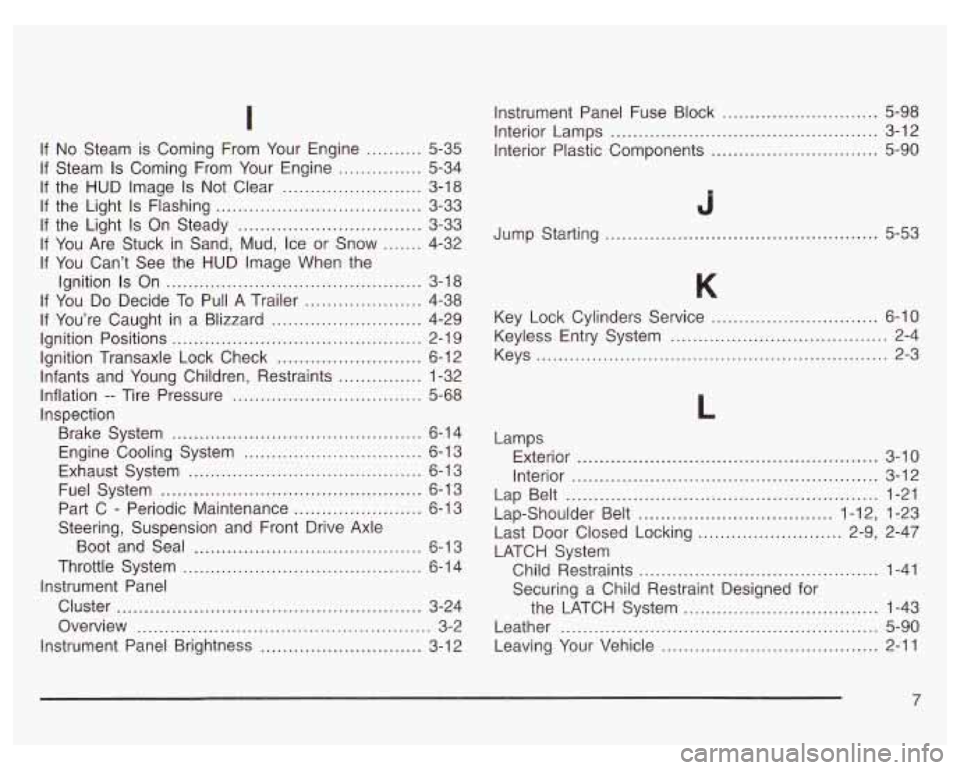
If No Steam is Coming From Your Engine .......... 5-35
If Steam
Is Coming From Your Engine ............... 5-34
If the HUD Image
Is Not Clear ......................... 3-18
If the Light
Is Flashing ..................................... 3-33
If the Light
Is On Steady ................................. 3-33
If You Are Stuck in Sand, Mud, Ice or Snow
....... 4-32
If You Can’t See the HUD Image When the
Ignition
Is On .............................................. 3-18
If You
Do Decide To Pull A Trailer ..................... 4-38
Ignition Positions
............................................. 2-1 9
Ignition Transaxle Lock Check
.......................... 6-12
Infants and Young Children, Restraints
............... 1-32
Inflation
-- Tire Pressure ............................... 5-68
Inspection Brake System
........................... ........... 6-14
Engine Cooling System
................................ 6-13
Exhaust System
.......................................... 6-13
Fuel System
............................................... 6-13
Part C
- Periodic Maintenance ....................... 6-13
Steering, Suspension and Front Drive Axle
Boot and Seal
......................................... 6-1 3
Throttle System
........................................... 6-14
Cluster
....................................................... 3-24
Overview
..................................................... 3-2
Instrument Panel Brightness
............................. 3-1 2
If
You’re Caught in a Blizzard
........................... 4-29
Instrument Panel Instrument Panel
Fuse Block
........................ 5-98
Interior Plastic Components .............................. 5-90
Interior
Lamps
................................................ 3-12
Jump Starting
................................................. 5-53
Key Lock Cylinders Service .............................. 6-10
Keyless Entry System
....................................... 2-4
Keys
............................................................... 2-3
L
Lamps Exterior
............................................... 3-10
Interior
....................................................... 3-12
Lap Belt
........................................................ 1-21
Lap-Shoulder Belt
................................... 1.12. 1-23
Last Door Closed Locking
.......................... 2.9. 2-47
LATCH System Child Restraints
........................................... 1-41
Securing a Child Restraint Designed for
the LATCH System
................................... 1-43
Leather
......................................................... 5-90
Leaving Your Vehicle
....................................... 2-11
7
Page 373 of 378

To Use the Engine Coolant Heater .................... 2-23
Top
of the Instrument Panel ............................. 5-90
Top Strap
...................................................... 1-39
Top Strap Anchor Location
............................... 1-40
Torque Lock
................................................... 2-29
Total Weight on Your Vehicle’s Tires
.................. 4-39
Towing
Recreational Vehicle
..................................... 4-33
Towing a Trailer
.......................................... 4-37
Your Vehicle
............................................... 4-33
Control System (TCS)
.................................. 4-10
Traction
Control System Warning Light
....................... 3-29
Enhanced Traction System (ETS)
................... 4-1 1
Warning Light .......................................... 3-30
Enhanced
Traction System (ETS)
Low Light
................................................... 3-30
Trailer Brakes
................................................. 4-40
Transaxle Fluid, Automatic
....................................... 5-27
Transaxle Operation, Automatic
......................... 2-24
Transmission, Transaxle, Transfer Case Unit
Transportation Options
...................................... 7-7
Trip Computer
................................................ 3-40
Control Buttons
........................................... 3-42
Functions
.................... ............ 3-42
Trip Odometer
.......... ............ 3-25
Repair
Manual
............................................ 7-10 Trunk
........................... ................. 2-11
Trunk Access Panel
..., .... ............. 2-41
Trunk Lock
................................................ 2-11
Turn SignaVMultifunction Lever
........................... 3-5
Turn Signals When Towing a Trailer
.................. 4-42
Turn
and Lane-Change Signals
............... ... 3-5
Underbody Flushing Service
............................. 6-12
Underhood Fuse Block
................................... 5-100
Understanding Radio Reception ........................ 3-57
Uniform Tire Quality Grading
............................ 5-72
United States
................................................... 7-4
Unlocking the Theft-Deterrent Feature
After a Power Loss
...................................... 3-55
Used Replacement Wheels
.............................. 5-74
Using Cleaner on Fabric
.................................. 5-89
Variable Effort Steering
.................................... 4-13
Vehicle Control
........................................................ 4-6
Damage Warnings
........................................... iv
Loading
...................................................... 4-35
Symbols
......................................................... iv
14